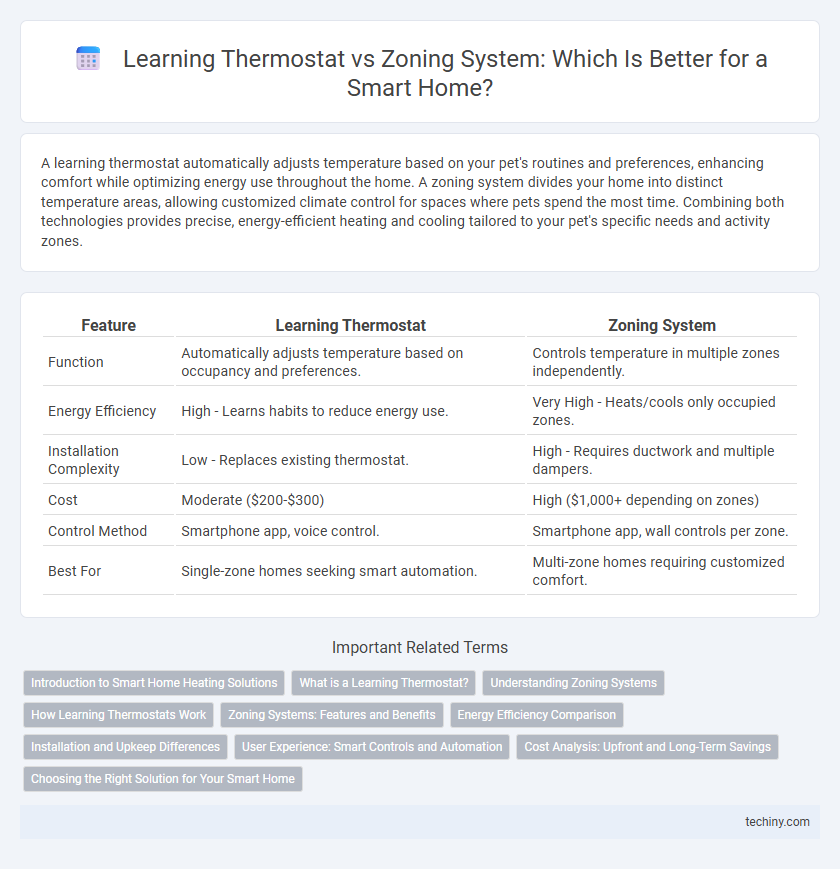A learning thermostat automatically adjusts temperature based on your pet's routines and preferences, enhancing comfort while optimizing energy use throughout the home. A zoning system divides your home into distinct temperature areas, allowing customized climate control for spaces where pets spend the most time. Combining both technologies provides precise, energy-efficient heating and cooling tailored to your pet's specific needs and activity zones.
Table of Comparison
| Feature | Learning Thermostat | Zoning System |
|---|---|---|
| Function | Automatically adjusts temperature based on occupancy and preferences. | Controls temperature in multiple zones independently. |
| Energy Efficiency | High - Learns habits to reduce energy use. | Very High - Heats/cools only occupied zones. |
| Installation Complexity | Low - Replaces existing thermostat. | High - Requires ductwork and multiple dampers. |
| Cost | Moderate ($200-$300) | High ($1,000+ depending on zones) |
| Control Method | Smartphone app, voice control. | Smartphone app, wall controls per zone. |
| Best For | Single-zone homes seeking smart automation. | Multi-zone homes requiring customized comfort. |
Introduction to Smart Home Heating Solutions
Learning thermostats use adaptive algorithms to optimize home heating by learning occupant schedules and preferences, improving energy efficiency and comfort. Zoning systems divide a home into multiple areas with independent temperature controls, allowing tailored heating and reduced energy waste in unoccupied zones. Both solutions enhance smart home heating by providing precise control and automation to reduce energy costs and increase user convenience.
What is a Learning Thermostat?
A learning thermostat is an intelligent climate control device that adapts to your daily schedule and preferences by using machine learning algorithms. It automatically adjusts temperature settings to optimize energy efficiency and comfort, reducing heating and cooling costs. Unlike traditional thermostats, it can integrate with smart home systems and be controlled remotely via smartphone apps.
Understanding Zoning Systems
Zoning systems divide a home into distinct areas, each controlled by individual thermostats to provide personalized temperature settings and improved energy efficiency. Unlike a single learning thermostat that adjusts based on overall home patterns, zoning systems optimize comfort by directing heating or cooling only to occupied zones. This targeted approach reduces energy waste and enhances climate control precision within multi-room environments.
How Learning Thermostats Work
Learning thermostats use advanced sensors and algorithms to monitor home temperature patterns and occupant behavior, automatically adjusting heating and cooling settings for optimized energy efficiency. By analyzing data such as time of day, weather conditions, and room occupancy, these devices create custom schedules that reduce energy waste while maintaining comfort. Integration with mobile apps and smart home systems allows remote control and real-time adjustments, enhancing convenience and cost savings.
Zoning Systems: Features and Benefits
Zoning systems enhance smart home climate control by dividing a house into multiple zones, each with independent temperature settings tailored to occupant preferences. These systems improve energy efficiency by heating or cooling specific areas only when needed, reducing overall utility costs. Integration with smart thermostats and sensors allows for precise climate management, maximizing comfort and minimizing energy waste.
Energy Efficiency Comparison
A learning thermostat adapts to user preferences and occupancy patterns to optimize heating and cooling schedules, resulting in significant energy savings by avoiding unnecessary temperature adjustments. In contrast, a zoning system divides a home into multiple zones with independent temperature controls, enabling targeted heating or cooling only in occupied areas, which minimizes energy waste. Combining a learning thermostat with a zoning system can further enhance energy efficiency by leveraging intelligent scheduling alongside precise zone control.
Installation and Upkeep Differences
Learning thermostats offer straightforward installation, often compatible with existing HVAC systems, requiring minimal wiring and user setup. In contrast, zoning systems involve a more complex installation process with multiple dampers and separate thermostats for different zones, demanding professional calibration and frequent maintenance. Upkeep for learning thermostats is generally low, mainly software updates, while zoning systems require regular mechanical inspections to ensure optimal airflow and system balance.
User Experience: Smart Controls and Automation
Learning thermostats enhance user experience through intuitive smart controls and adaptive automation that learns household patterns to optimize comfort and energy efficiency. Zoning systems offer precise temperature management for different areas, enabling tailored climate control via smart devices or apps, improving overall convenience. Both systems integrate seamlessly with home automation platforms, but learning thermostats excel in predictive adjustments, while zoning systems prioritize spatial customization.
Cost Analysis: Upfront and Long-Term Savings
Learning thermostats typically have a moderate upfront cost ranging from $200 to $300, with long-term energy savings of 10-15% due to optimized temperature control. Zoning systems involve higher installation costs, often between $1,500 and $4,000, but provide significant long-term savings by allowing precise control over multiple areas, reducing HVAC energy consumption by up to 30%. Evaluating cost-effectiveness depends on home size, existing HVAC infrastructure, and the desired level of temperature customization.
Choosing the Right Solution for Your Smart Home
Learning thermostats use adaptive algorithms to optimize temperature settings based on user behavior, offering energy savings and convenience in single-zone environments. Zoning systems divide a home into multiple areas with independent temperature controls, ideal for larger homes or households with varied heating and cooling needs. Selecting between a learning thermostat and a zoning system depends on home size, lifestyle preferences, and the complexity of desired climate control integration within the smart home ecosystem.
Learning Thermostat vs Zoning System Infographic

 techiny.com
techiny.com